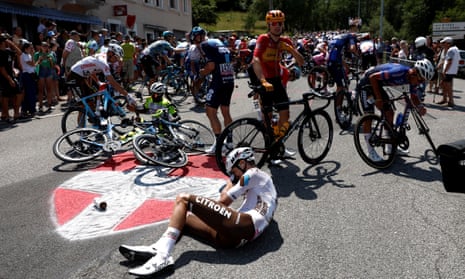The team of the Tour de France leader, Jonas Vingegaard, are considering pressing charges after a spectator caused a massive crash during the 15th stage to Saint-Gervais Mont‑Blanc on Sunday.
One of the defending champion’s key Jumbo-Visma teammates, the American climber Sepp Kuss, crashed after being caught by the outstretched arm of a fan as the peloton raced past. Kuss’s fall caused a domino effect through the peloton with multiple other riders also hitting the tarmac, in echoes of a similar incident caused by a fan with a placard, endured by the same team in the 2021 race.
Quick GuideHow do I sign up for sport breaking news alerts?
Show
- Download the Guardian app from the iOS App Store on iPhone or the Google Play store on Android by searching for 'The Guardian'.
- If you already have the Guardian app, make sure you’re on the most recent version.
- In the Guardian app, tap the Menu button at the bottom right, then go to Settings (the gear icon), then Notifications.
- Turn on sport notifications.
According to Reuters, the gendarmerie have identified the individual but will not arrest them unless Kuss wishes to take matters further. However, a spokesperson for Jumbo-Visma said: “The team might. We’ll find out how and when.”
The weekend’s stages were marked by several incidents involving race motorbikes and overexcited spectators. On Saturday, media motorbikes were slowed and hemmed in by large crowds at the top of the Col de Joux Plane and, as well as the mass fall on Sunday, the Latvian rider Krists Neilands also crashed while taking a drink from an in-race motorbike on a fast Alpine descent.
Team Cofidis were one of those to tell spectators that they “don’t need a cellphone to make memories”. However, the Tour de France entered into a new partnership with the social media giant TikTok shortly before this year’s race began and has actively encouraged fans to create content.
In a press release from 22 June, Julien Goupil, the media and partnerships director for the Tour promoter, ASO, described TikTok as a “perfect match” for the Tour and said “the content created at the roadside will enhance existing coverage and bring the public together around the event even more widely”.
Conscious of the need for a younger demographic of fans and influencers, the Tour has been seeking to attract a new audience for several years and is itself extremely active on social media. Selfie sticks, phones and even rogue drones are also commonplace at the roadside, despite the Tour’s best efforts to limit any interference in the racing.
But this is an impossible task. The Tour de France is a free, unticketed event that draws hundreds of thousands to the roadside, especially when it arrives in the mountains, where sleep-deprived fans camp out for days on end, living on a diet of sunshine, cheap beer and not-so-fine wines.
In reality, it is a health and safety nightmare and has been so for more than a century. The most renowned climb for spectator interaction is the hair-pinned ascent to Alpe d’Huez, where organised chaos somehow prevails as the riders pass through the sea of partying fans.
When Giuseppe Guerini broke clear of the peloton and climbed towards a career-best victory on the prestigious stage to the Alpe in July 1999, he didn’t expect to be brought down by a bespectacled 19-year-old wielding an Instamatic camera. But the Italian rider hadn’t reckoned with Eric, surname unknown, standing motionless in the middle of the most famous climb in cycling, waiting to click his shutter. The pair collided, Guerini fell, then got to his feet, received a push from the hapless Eric, yet carried on to win the stage.
after newsletter promotion
More recently, in 2016, the planned finish at the top of Mont Ventoux was aborted because of high winds at the summit and the finish line brought much lower down the mountain to Chalet Reynard. Thousands of spectators moved to the new finish line, and overcrowding caused a blockade of fans, motorbikes and fallen riders including the race leader, Chris Froome, who, with his team car blocked by the throng, opted to jog most of the remaining distance.
Such incidents are as old as the Tour itself. Tacks on the road, dogs and sometimes even horses blocking the path of riders, while brawling partisan fans trying to sabotage a rival and protesters – ranging from farmers, to fisherman and climate activists – are all part of the Tour’s history. Only a massive police presence, a huge investment in crowd barriers and the increased awareness of occasional cycling fans, rather than diehards, will eradicate the problem.
Meanwhile the duel in the sun, between Vingegaard and his closest rival, Tadej Pogacar of UAE Team Emirates, who are separated by only 10 seconds, resumes on Tuesday in the 22.4km time trial from Passy to Combloux, at the foot of Mont Blanc.
It has also been confirmed that Vingegaard, whether he becomes Tour champion or not, will not be racing for Denmark in the Glasgow-based UCI world championships in August.
